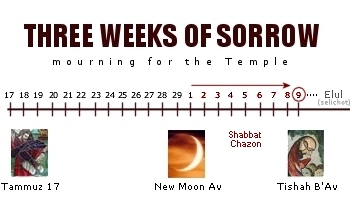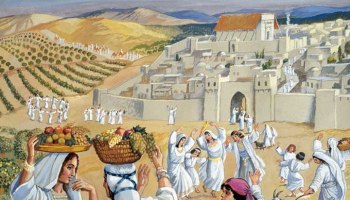Mayday or Main Day?
Mayday or Main Day?
Shalom,
We are now going through the 21 days of what is called in Hebrew “Yamey Bein HaMetzarim” – ימי בין המצרים
Days of Distress.
These 21 days refer to the period of time that passed between the breaking through the wall of Jerusalem on the 17th of the month of Tamuz and the destruction of both Temples on the 9th of month of Av, which occurs this year July 31st and ends on Tuesday, Aug 1st.
The first Temple built by King Solomon was destroyed on the 9th of Av in 586 B.C.E by the army of the Babylonian king, Nebuchadnezzar.
The second Temple was destroyed on the 9th of Av in 70 CE by the Roman legions commanded by the emperor Titus.
The verse in Lamentations 1:3 states:
Judah has gone into exile because of suffering and harsh toil. She dwelled among the nations but found no rest; all her pursuers overtook her in the narrow straits
[in Hebrew, ‘bein hametzarim‘ – בין המצרים].
The famous commentator Rashi points out that the term “bein hametzarim” can be also translated as “between the days of distress”.
צר = Narrow
צרה = Trouble / Distress
This Shabbat we will read two joint weekly Torah portions “Matot-Mas’ey” – מטות – מסעי
In ‘Masey’ we learn about 42 journeys and their stops (camping places) of the People of Israel in the desert before they reached the Land of Israel.
(Mas’ey – מסעי comes from the root נסע – to travel).
What is the significance of the number of these journeys?
According to our sages these 42 journeys represent rectifications that People of Israel must go through before reaching final redemption, coming to the Land of Israel.
These journeys and stops actually correlate to this period of 21 days and 21 nights (together – 42).
During the period of the 21 days of Bein HaMetzarim we tend to indulge in anguish and sorrow over the destruction of both Temples.
However, there is another side to this coin.
According to our sages the same 21 days correlate to the number of the days of rejoicing in the Jewish calendar:
- Pesach – 7 days
- Shavuot – 1 Day
- Sukkot – 7 day
- Shmini Atzeret – 1 day
- Rosh Hashana – 2 days
- Yom Kippur – 1 day
- Rosh Chodesh – 1 day
- Shabbat – 1 day
Altogether – 21 days of rejoycing
Thus, the period of these 21 days is the time when one can draw inner strength and fill his / her spirit with fate, hope and joy!
Our sages tell us that the day of Tish’a Be’Av will eventually turn into a day of thanks and rejoicing.
The Talmud tells us about Rabbi Yehuda HaNassi who wanted to uproot Tish’a Be’Av if it fell out on Shabbat.
Rabbi Yaakov Yitzhak Horowitz of Lublin explains the intention of Rabbi Yehuda HaNassi in a unique way:
“When Rebbe wanted to uproot [in Hebrew, “la’akor – לעקור“] Tisha B’Av, he wanted to make it the foremost [in Hebrew, “ha’ikar” – העיקר – main / important, spelled with the same root letters עקר as “la’akor”] amongst all the holidays of the year.
Thus, one can turn Tisha B’Av from ‘Mayday‘ to ‘Main day’ – a turning point toward joy and freedom and yearn more deeply for the restoration of our nation and the final redemption.
And we hope that Tish’a Be’Av soon will turn into a day of thanks and rejoicing.
Shabbat Shalom,











